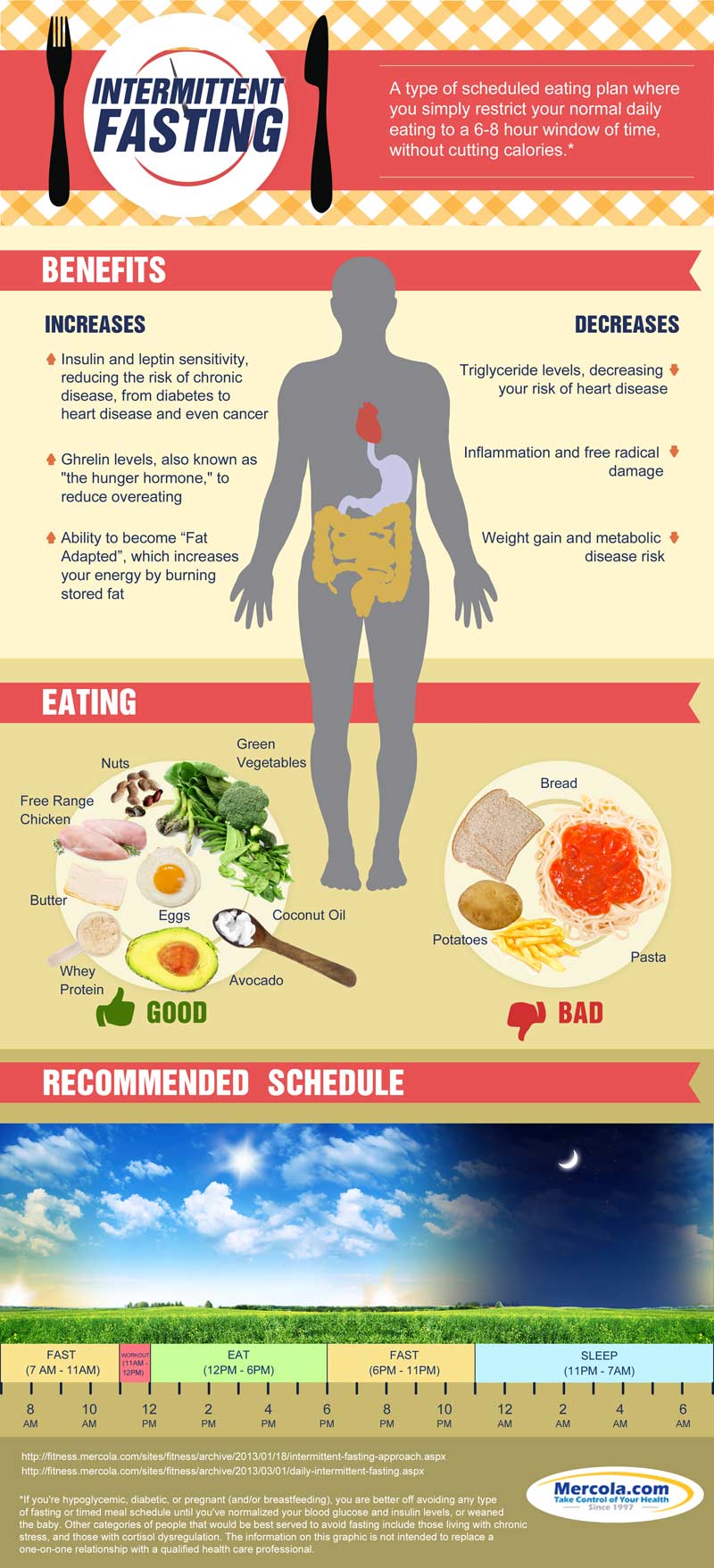Intermittent Fasting (IF) is best described as a short-term absence from food.
This kind of diet is much different from prolonged fasting that can involve many days of no food and can be dangerous to one’s health.
Even though Intermittent Fasting has been trendy for several years it’s just now coming into its own and drawing the attention of many as a method of losing weight that is practical and easy to manage.
As with all weight loss methods that haven’t yet become mainstream, there are those who say that IF isn’t safe for a variety of reasons. Some of the researches show that intermittent fasting can reduce the risk of serious illness, improve health and longevity.
The simple act of not ingesting foods for short periods of time allows the body to rest (no digesting) and to clean itself by taking out toxins from the body system.
In addition, intermittent fasting has also been shown to reduce stress; it is believed that flushing toxins from the body aids in stress relief.
During the Intermittent Fasting diet period, the body looks for other sources to supply energy. The source most readily available is fat cells. Your body breaks down the fat cells and converts them into energy.
The body DOESN’T attack your muscle mass. When the body breaks down fat cells toxins leave these cells. In order for the system to adequately remove the toxins from the body, your body will need water.
To make the IF quite effective, it’s important to drink plenty of water while fasting, thus removing and flushing toxins from the system. Many people advise that drinking green tea along with water is beneficial while in the fasting stage.
Intermittent Fasting aids in weight loss mainly because:
- While fasting caloric intake is reduced to zero;
- The body breaks down fat cells to supply energy.
In a nutshell, Intermittent Fasting is quite a safe and beneficial method to lose weight and to retain muscle mass.
Check out more on intermittent fasting from Dr. Mike in this video below:
Related Article: How to Lose Weight Fast: 10 pounds in 1 Week: Experts’ Advice
What are the Variations of Intermittent Fasting?
As with all “new” weight loss methods, there are some people who try to find fault or issues that may harm the body. One of the biggest myths about Intermittent Fasting is that you will lose muscle mass and tone.
Nothing could be far away from the truth.
The fact is that you’ll gain muscle tone just by flushing toxins from the body. For more in-depth information on Intermittent Fasting read Brad Pilon’s’ book Eat Stop Eat.
Intermittent Fasting can easily be successful for everyone because the method is not ‘set in stone’, and should meet individual needs.
Imagine going out for lunch with friends, seeing the food that you like most. You want to order it but you have to say those irritating words: “I can’t have that; I’m on a diet”. Or even worse – “I can’t go there; I’m on a diet.”
Here’s advice for you: Go eat. Enjoy., and still, lose weight.
Here we will go through the three variations of Intermittent Fasting and will explore the two of the most frequently asked questions relating to IF. Undoubtedly, you’ll find the method that will fit your lifestyle.

Variation # 1
The most basic of Intermittent Fasting methods is to fast for 24 hours and then eat normally for the next 24 hours. In other words, fast every second day.
Some groups of people prefer this method as the best one for their lifestyle. It’s quite easy to remember when you should and shouldn’t eat. They feel when to eliminate toxins from the body.
The other group of people finds that this method a boring one and too restrictive for their lifestyles. They quickly become tired of missing meals with the family every other day.
Variation # 2
The second variation involves fasting two or three days a week and eating normally the remaining days. You can choose to fast on Mondays and Thursdays so you can eat normally for lunch on Friday or during the weekend.
It’s totally up to you to choose the weekdays that work best for you.
This method often works best for people that should balance overloaded schedules at work and at home. It affords the luxury of being able to pick the days that fasting will fit into their schedule while allowing for social interactions with family and friends as well as business associates that involve eating a meal.
Variation # 3
Finally, the third intermittent fasting variation. With this variation, people can choose certain hours during every 24 hour period.
For example, I choose to fast daily, from 7:00 pm to 11:00 am. This schedule works very well for the busy person that has family considerations.
One of the most important daily events for a family is dinner time when all the family members’ time unity.
This method also allows busy people to implement IF diet during lunch. Exploring more on IF will help you master the basic skills and features transforming your body.
Nevertheless, each IF variation has its pros and cons, so explore as much as possible before you make a decision of keeping this diet.
What Should You Eat During Intermittent Fasting?
What you choose to eat can be combined with any of the 3 Intermittent Fasting methods described.
One of the proven methods experts advise is that you place no restrictions on what you eat when not fasting.
If you’re a “healthy eater” then this may work for you.
On the other hand, if you normally eat foods that are full of fats and sugars the weight loss process will last much slower and less healthy for you.
Many people like to mix Intermittent Fasting with a particular diet that works well for them. For instance, in many cases include low carb/high protein diets or the Paleo method of eating, among others.
In the case of many people, Intermittent Fasting starts to help ONLY when they cut out dry carbs, sugar, and alcohol. It may take some experimenting, but you will find what works best for you and your lifestyle.
If you want to get more information on IF healthy eating, schedule in this infographic below from Mercola.com:

How Much Exercise Should I Do?
While there is no compulsory exercise along with Intermittent Fasting, you can exercise anyway.
Overall, leading a totally sedentary lifestyle is not a good idea. It’s bad for the heart, circulatory or digestive systems.
If you don’t currently exercise it wouldn’t be a good idea for you to take off tomorrow morning and try to run five miles.
The best way to incorporate exercise into your life is to start slowly and work up to a more rigorous routine. Begin by walking, increase the length of your walk daily. In a while, you can even start running. When you feel that you’re ready, try jogging half the distance of your walk.
Many forms of exercise are fun to do. Some examples include swimming, heavy bag training, playing baseball or basketball, or walking the dog. Choose the one that attracts you most, do your best, and increase the intermittent fasting impact on your health.
Good luck! 😉
James is the Founder & CEO of GurusWay.com. Majoring in Business and other life-changing sectors, James covers helpful content and shares his experience with the targeted audience.